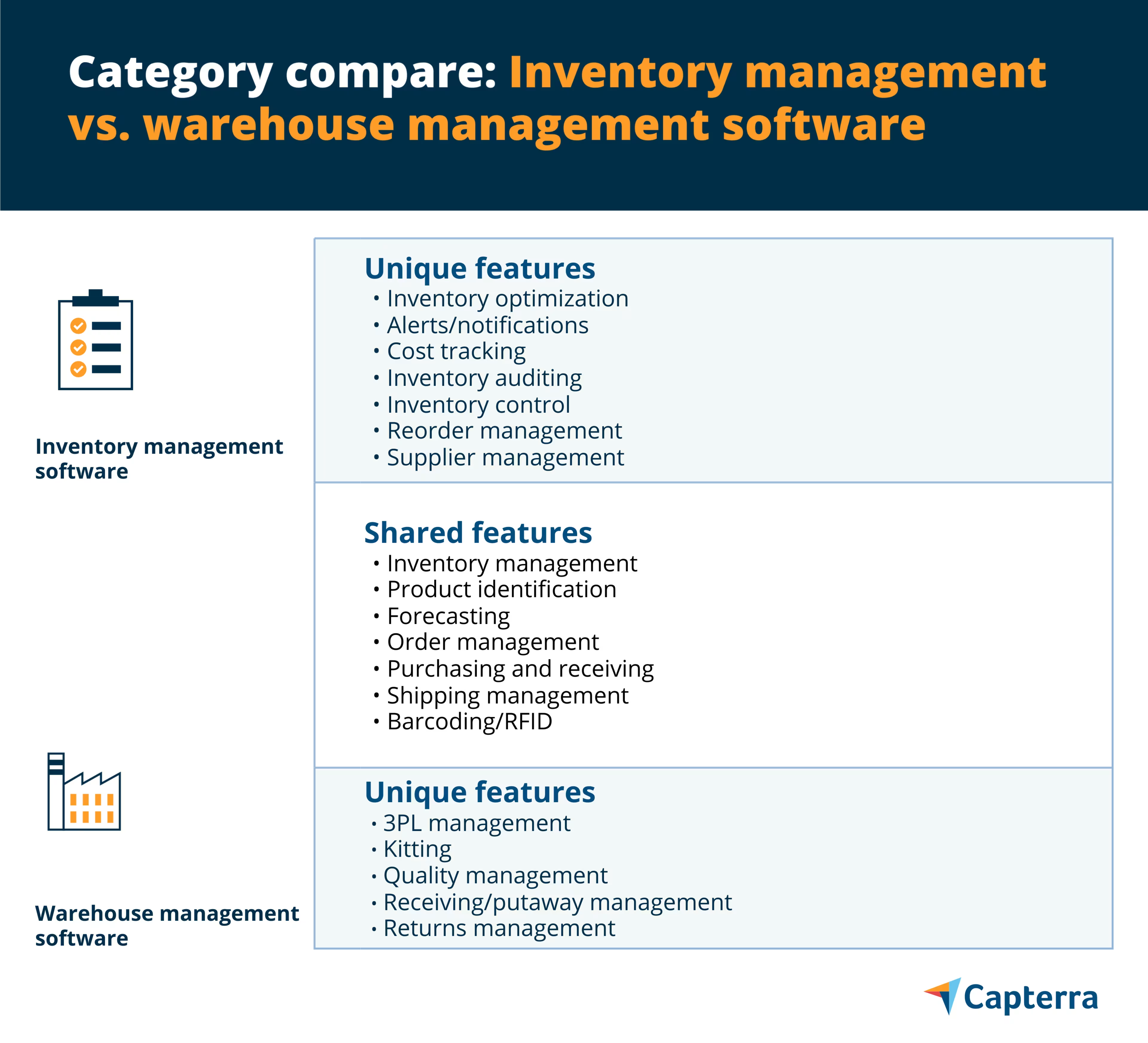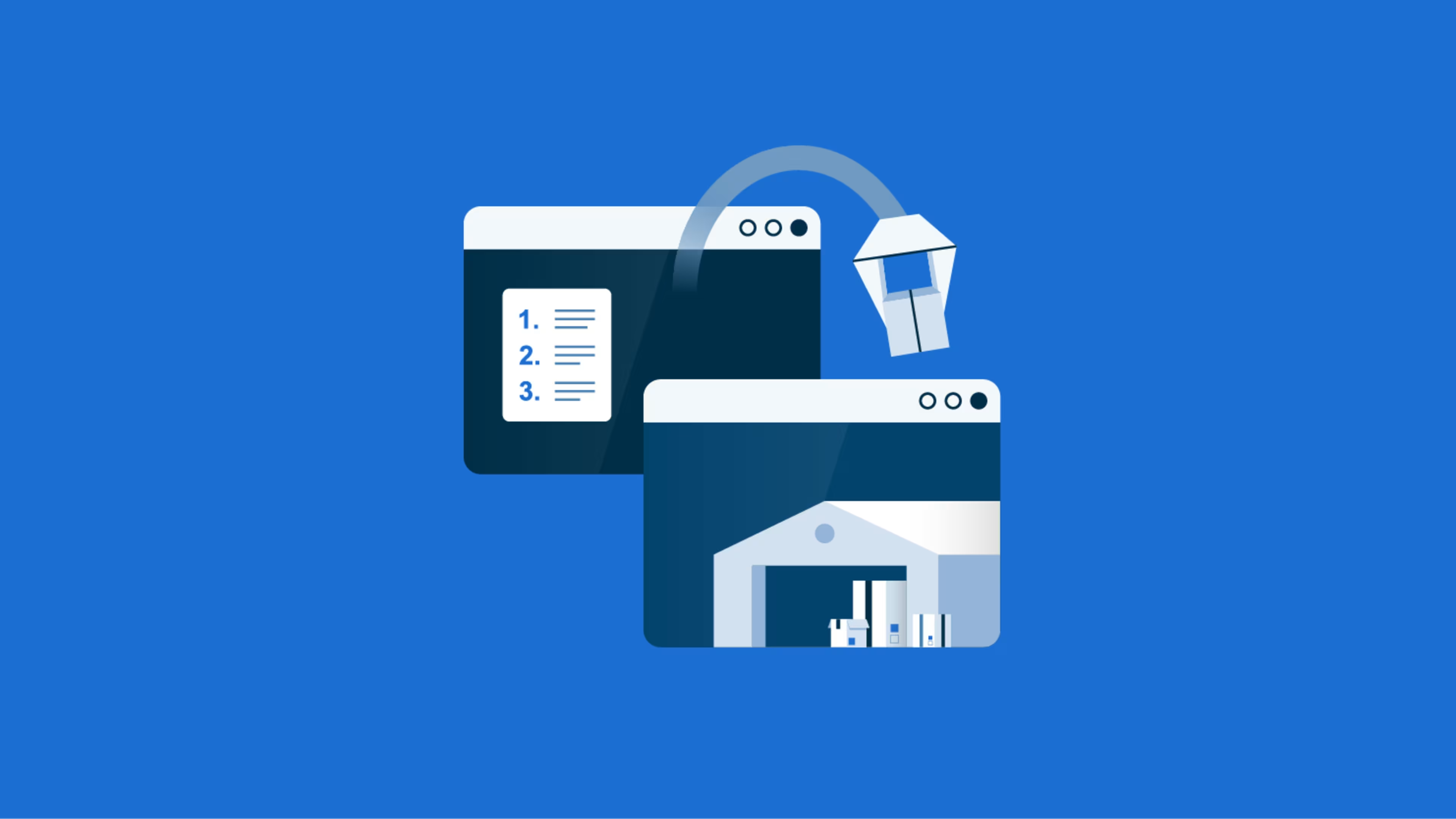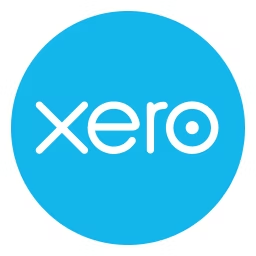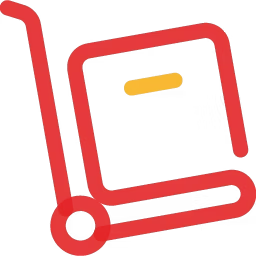Confused between inventory management and warehouse management software? Both these software tools play a vital role in supply chain operations by managing inventory fulfillment processes. However, they have several notable differences.
Warehouse management has a broader scope, encompassing inventory management within its operations. While inventory management focuses on tracking and managing product stock levels and movements, warehouse management includes organizing and optimizing warehouse space, storing and managing inventory, handling labor and resources, packing and shipping, and overall warehouse operations.
This article discusses the similarities and differences between inventory management vs warehouse management software so you can select the right one for your business needs. We've also included each category's top five products based on verified software reviews. Read more.

What is inventory management software?
Inventory management software allows businesses to track and manage their product inventory levels. It provides complete visibility into stock movement, helping maintain optimal levels and predict future demand via real-time inventory reporting. These tools also analyze historical inventory trends, record seasonal demand, and identify risks in the supply chain to support data-driven decision-making.
Inventory management solutions send proactive alerts regarding low inventory levels, shipment delays, and supply chain disruptions. Many tools also automate the reordering process for best-selling items, allowing businesses to set minimum stock quantity requirements for each item. Once the specified threshold is reached, the system automatically generates a purchase order, ensuring optimal product levels are maintained.
Core features of inventory management software
Below are the core features of inventory management software:
- Inventory management: Track the quantity and availability of each item in the inventory to maintain proper supply. This feature helps optimize inventory levels by providing insights on reorder points, safety stock levels, and economic order quantities (EOQ)Economic Order Quantity (EOQ) is a calculation used in inventory management to determine the optimal order quantity for a product that minimizes total inventory costs. The primary goal of EOQ is to find a balance between ordering costs and carrying costs, ensuring that the right amount of inventory is ordered at the most cost-effective intervals., minimizing holding costs while meeting demand.
Inventory optimization: Optimize and balance inventory stock by analyzing demand patterns, historical sales data, and supply chain performance. This feature helps manage stock and minimize excess or insufficient inventory.
Product identification: Interlink specific items with unique identifiers such as barcodes, stock keeping units (SKUs), or serial numbers. This feature helps categorize products based on attributes such as weight, height, lot number, and batch details, improving traceability for inventory managers.
What is warehouse management software?
Warehouse management software enhances the storage and movement of inventory within a warehouse, enabling businesses to monitor warehouse operations throughout the inventory lifecycle. By providing end-to-end operational visibility, it facilitates the optimum utilization of warehouse space. It also helps manage the warehouse workforce and coordinate customer orders with the shipping of items from the warehouse.
By using barcode readers and radio frequency identification (RFID) tags, the software tracks inventory movement within the warehouse. This information is instantly updated on the software's dashboard, ensuring accessibility for all stakeholders. Additionally, the software sends automated alerts to notify warehouse managers about low inventory levels, delayed deliveries, short picks, and missing stock.
Core features of warehouse management software
The core features of warehouse management software are:
Barcoding/RFID: Monitor physical inventory using barcodes or RFID technology. This feature allows warehouse managers to scan and identify received, sold, and transferred products, improving inventory visibility.
Inventory management: Track stock levels, locations, movement, and reconciliation. Inventory management helps maintain optimal stock levels and predict future demand via real-time inventory reporting.
Shipping management: Optimize the shipping process within the warehouse to improve order fulfillment and ensure timely delivery of goods. This feature includes order consolidation, carrier selection, shipping label generation, and shipment tracking.
What are the differences between inventory management and warehouse management software?
Inventory management and warehouse management tools are both crucial components of supply chain operations, but they serve distinct purposes and offer unique functionalities. Here are some differences between the two categories:
Business focus: Inventory management software primarily focuses on tracking and optimizing inventory levels, ensuring accurate stock counts, and simplifying order fulfillment processes. It provides visibility into inventory status, demand forecasting, and inventory control. On the other hand, warehouse management software has a broader scope and focuses on managing all aspects of warehouse operations, including inventory movement, storage, picking, packing, and shipping. It encompasses warehouse layout optimization, labor management, and workflow automation.
Scope of inventory control: Inventory management software typically provides a high-level view of inventory levels and movements. It can track inventory across locations but may not provide details about specific locations within a warehouse. On the other hand, warehouse management software offers a much more granular view of inventory control. It can track the exact location of inventory within a warehouse, and it can also track the status of individual inventory items. This level of detail helps optimize warehouse operations and ensure accurate order fulfillment.
Pricing: The pricing range for inventory management software is typically between $10 to $65 per user, per month. Contrarily, pricing for warehouse management software generally falls between $20 to $100 per user, per month. The variation in pricing depends on factors such as the vendor, number of warehouses, inventory size, supply chain requirements, and level of customization required.
What are the similarities between inventory management and warehouse management software?
Despite the distinctions, both software categories have some common functionality, including:
Order management: Both inventory management and warehouse management tools enable businesses to receive, process, and fulfill orders. This feature includes order tracking, order picking, and order status updates.
Shipping management: Both types of software help businesses improve their shipping process, generate shipping labels, and track shipments. This ensures accurate and timely delivery of orders to customers.
Forecasting: Both inventory management and warehouse management platforms support forecasting capabilities. They utilize historical data, sales patterns, and other factors to predict future demand. This aids in optimizing inventory levels, ensuring sufficient stock availability, and reducing the risk of stockouts or overstock situations.
Inventory management vs. warehouse management software: Which one is right for your business?
Choosing between inventory and warehouse software solutions depends on your business's needs and priorities.
If your goal is maintaining optimal product levels, checking stock availability, and enhancing order fulfillment, invest in an inventory management system. This software will provide location-wise inventory overviews, aid in inventory forecasting, and support the ordering process.
If your priority is to have complete visibility into your warehouse operations, including inventory movement within warehouses or between locations, opt for a warehouse management system. This software will monitor and manage inventory levels within your warehouse, track sales invoices, monitor incoming and outgoing inventory, and support inventory audits.
Once you've decided which software to use, head to our inventory management and warehouse management software category pages to find a list of products and software reviews from verified users.
If you want to narrow your search to only the most popular and highest-rated solutions, visit Capterra Shortlist reports for the top inventory management software and warehouse management software tools—our reports are based on an analysis of thousands of user reviews.
How to choose between inventory management and warehouse management software
Below are a few things to consider when selecting between inventory and warehouse management solutions.
Determine your business requirements. As discussed, inventory management solutions track and manage inventory levels, optimize order fulfillment processes, and provide insights into demand forecasting. If you need a broader range of integrated functionalities that cover multiple areas beyond inventory management, warehouse management software should be your pick.
Assess automation capabilities. Both inventory management and warehouse management tools offer automation capabilities to simplify operations and reduce manual work. However, each automates distinct processes. Inventory management software automates order routing, barcode scanning, inventory replenishment, and reporting tasks. On the contrary, warehouse management software automates product picking, packing, shipping, and receiving. To pick the right tool, identify the processes you want to automate and assess the extent to which the software can automate them.
Evaluate reporting/analytics features. While both solutions offer reporting functionality, warehouse management software typically includes more advanced reporting and analytics features, such as real-time data visibility and drill-down capabilities. If you need to track key performance indicators (KPIs), including inventory accuracy, order fulfillment rate, on-time delivery, and warehouse utilization, to improve operational efficiency, warehouse management software is the better choice.
5 top-rated inventory management software
These products are listed in alphabetical order. (Check how we selected them.)
To present the most up-to-date information, the product information below shows the latest real-time ratings, which may differ from the ratings values at the time this report's analysis was conducted, since new reviews may have been left in the meantime.
Trial/Free Version
- Free Trial
- Free Version
Device compatibility
Trial/Free Version
- Free Trial
- Free Version
Device compatibility
Trial/Free Version
- Free Trial
- Free Version
Device compatibility
Trial/Free Version
- Free Trial
- Free Version
Device compatibility
Trial/Free Version
- Free Trial
- Free Version
Device compatibility
5 top-rated warehouse management software
These products are listed in alphabetical order. (Check how we selected them.)
To present the most up-to-date information, the product information below shows the latest real-time ratings, which may differ from the ratings values at the time this report's analysis was conducted, since new reviews may have been left in the meantime.
Trial/Free Version
- Free Trial
- Free Version
Device compatibility
Trial/Free Version
- Free Trial
- Free Version
Device compatibility
Trial/Free Version
- Free Trial
- Free Version
Device compatibility
Trial/Free Version
- Free Trial
- Free Version
Device compatibility
Trial/Free Version
- Free Trial
- Free Version









